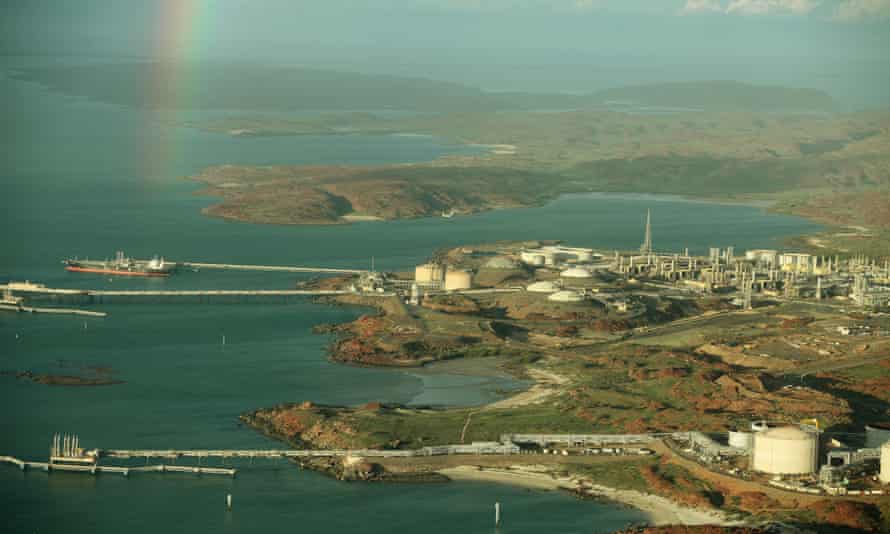Woodside’s proposed Scarborough development is equivalent of 15 coal-fired power plants, environment experts say.

Last modified on Thu 3 Jun 2021 09.04 AEST
A proposed gas export development in northern Western Australia could result in more than 1.6bn tonnes of greenhouse gas emissions across its lifetime and damage Indigenous rock art, environment and climate campaigners say.
A report by two groups – the Conservation Council of Western Australia and the Australia Institute – said the Scarborough to Pluto liquified natural gas (LNG) development appeared on the cusp of being approved without a full environmental impact assessment from state or federal authorities.
Released on Thursday, the report suggested the development could lead to lifetime emissions equivalent to that released by 15 coal-fired power plants. The project includes the development of a new gas field more than 400km off the coast, piping infrastructure and an expanded processing facility in the Pilbara.
In annual terms, it found the project would release about 4.4m tonnes within Australia – adding the equivalent of nearly 1% to national emissions. The vast bulk of the emissions would occur in the countries that bought and burned the gas.
It would increase WA’s annual emissions by about 5% as the McGowan Labor government says it plans to help transition the state economy to reach net zero emissions by 2050. WA is the only state to have increased its emissions since 2005, largely due to the booming LNG industry.
Piers Verstegen, the conservation council’s director, said if fully realised the Scarborough project would be responsible for more emissions than the Adani coalmine in Queensland.
“It is an international outrage that any government would support a project which would result in over a billion tonnes of carbon pollution and cause irreversible impacts on Aboriginal heritage,” he said.
The project’s major proponent, Woodside, said there had been many opportunities for interested parties to comment on the proposal over the past two-and-a-half years. Through a spokesperson, the company said the development had been referred separately to state and commonwealth authorities as required.
The federal Department of Agriculture, Water and the Environment found in August 2019 the pipeline works did not have to be assessed under national conservation laws, and the National Offshore Petroleum Safety and Environment Management Authority had approved the development of the gasfield in April 2020.
At a state level, the Environment Protection Authority (EPA) last year approved the pipeline construction in WA waters near the shore and found the expansion of the processing facility was only a minor change to previous approval decisions and did not require a full assessment.
The spokesperson said Woodside was awaiting final approval from the WA environment and climate action minister, Amber-Jade Sanderson. If approved, a final investment decision on the $11bn development is expected later this year.
Woodside announced on Wednesday that the former WA Labor treasurer, Ben Wyatt, who retired from politics at the March state election, had been appointed a non-executive director of the company.
Verstegen said the piecemeal nature of the assessment meant there had been no consideration of whether the project was consistent with the latest climate science and the Paris agreement, or to properly consider the potential damage to Murujuga rock art on the Burrup Peninsula. He said the EPA should be asked to carry out a full independent assessment of the entire project.
He said not to do so would be “reckless in the extreme”, citing a recent major report by the International Energy Agency that found all fossil fuel expansion should end now if the planet is to meet the goals agreed in Paris.
The conservation council’s president, former Labor premier Carmen Lawrence, said many of the circumstances that led to Rio Tinto destroying an Aboriginal heritage site at Juukan Gorge applied to the Scarborough development.
“It is now clear that pollution from gas processing on the Burrup is having a significant effect on the Murujuga rock art,” she said. “Allowing further expansion of gas processing on this site will increase both the duration and severity of these impacts and this must be assessed carefully before any further decisions are made, not as an afterthought.
The conservation council has launched a supreme court challenge to the processing of gas from Scarborough at an expanded Pluto processing facility, and appealed the approval of the nearshore pipe development. On the former, the EPA supported a Woodside submission that this could be approved through a change in wording to a previous approval decision in 2007. The council has argued it should receive a full, new assessment on the grounds the ramifications of the change were significant.
A state government spokesperson said the EPA’s recommendations were based “on the best available evidence and scientific advice”. “There are a range of processes under the act to ensure good environmental outcomes. The minister for environment makes decisions on these matters after considering the advice and recommendations of the EPA,” they said.
Mark Ogge from the Australia Institute said the Scarborough project and Pluto expansion were “completely contrary” to global efforts to limit global heating to 1.5C. LNG developments in WA have driven an increase in national industrial emissions since mid last decade. “This is throwing fuel on the fire,” Ogge said.
The Woodside spokesperson said Scarborough contained less CO2 than other oil and gas reservoirs, and would deliver “one of the lowest carbon LNG sources in Australia”.
They said the company was aiming to be “net zero in our direct emissions by 2050 or sooner”. It has not set a target for its “scope 3” emissions – those from its products after they are sold.
BHP, a partner in the project, referred a request for comment to Woodside.

No comments:
Post a Comment